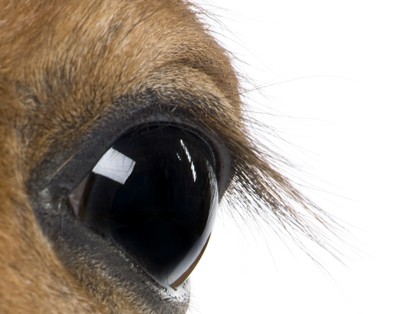My Horse Was Diagnosed with ERU… What is it?
Dr. Boggs explains why your horse’s health could be at risk.
QUESTION
A horse at my barn was diagnosed with ERU – what is it?
ANSWER
Equine recurrent uveitis (ERU), also known as moon blindness, is a painful condition where repeated occurrences of inflammation in the eye can cause permanent damage. The inflammation may cause career or even life-ending complications, explains Jacquelin Boggs, DVM, MS, Dipl. ACVIM, senior technical services veterinarian with Zoetis. ERU is the most common cause of blindness in horses worldwide.1
ERU is characterized by repeated occurrences, or flares, over the course of the horse’s life. The painful flares can reoccur months or even years apart; however, the interval between flares often shortens over the horse’s lifetime. With ERU, the horse’s immune system inappropriately attacks normal or host proteins in the eye, causing damage that can lead to blindness.
ERU can affect one or both eyes. You may notice an affected eye appearing cloudy or discolored. Your horse may squint or tear excessively, and the pupil may be constricted. These are frequently the first signs, with more severe changes to the eye developing with subsequent flare-ups. There is no cure for ERU. Even with the best treatment, many horses that develop recurrent uveitis won’t return to their previous level of performance.2
Equine recurrent uveitis is a multifactorial disease with a number of initial triggers. While there are many potential triggers, research indicates that the No. 1 trigger is leptospiral organisms, representing up to 70% of the ERU cases.3,4
Potential risk factors for Leptospira-associated uveitis include:
- Access to standing water or ponds
- Seasons that are wetter than usual
- Pasture flooding
- Exposure to skunks, white-tailed deer, raccoons, opossums or other wildlife near your horse’s pasture or barn
- Keeping feed in open containers or feeding on the ground
- Other animals on the property that have had ERU or mares that have aborted
1 Dwyer AE, Crockett RS, Kalsow CM. Association of leptospiral seroreactivity and breed with uveitis and blindness in horses: 372 cases (1986-1993). J Am Vet Med Assoc. 1995;207(10):1327-1331.
3 Polle F, Storey E, Eades S, et al. Role of intraocular Leptospira infections in the pathogenesis of equine recurrent uveitis in the southern United States. J Equine Vet Sci. 2014;34(11-12):1300-1306.
4 Borstel MV, Oey L, Strutzberg-Minder K, Boeve MH, Ohnesorge B. Direkter und indirekter Nachweis von Leptospiren aus Glask perproben von Pferden mit ERU. Pferdeheilkunde. 2010;2(M rz/April):219-225.
All trademarks are the property of Zoetis Services LLC or a related company or a licensor unless otherwise noted.
© 2016 Zoetis Services LLC. All rights reserved. LEI-00058











